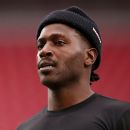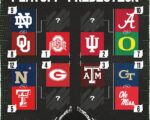When Antonio Brown walked out of Miami’s Turner Guilford Knight Correctional Center on Thursday, he smiled, hugged his attorney and unceremoniously headed to a food truck.
«God is great,» the former All-Pro wide receiver said before being trailed through the parking lot by cameras. The scene was a stark reminder of how dramatically Brown’s fortunes have changed since he last played in the NFL in 2021.
Recent months have been anything but great for Brown, 37, who had spent nearly six months in Dubai before being extradited and taken to New Jersey by U.S. marshals on Nov. 7. Four days later, he was in Miami, charged with second-degree attempted murder for an incident in May involving gunfire outside an amateur boxing match in Miami’s Little Haiti neighborhood. Brown, who faces up to 30 years in prison, pleaded not guilty last week and is scheduled for arraignment Monday.


1 Related
During a hearing last week, both Brown’s attorney and the prosecutor raised doubts about the alleged victim’s claim that a bullet fired by Brown possibly grazed his neck. Miami-Dade Circuit Court Judge Mindy S. Glazer set his bond at $25,000 and placed him on the least-restrictive house arrest with a GPS electronic ankle bracelet. That will keep him in the Miami area but allow him to work to support his family, which includes seven kids with an eighth on the way in June.
His attorney, Mark Eiglarsh, declined to make Brown available for an ESPN interview. «He was overwhelmed with gratitude, for me, for his freedom, and for the opportunity to finally see his family,» Eiglarsh said, adding that Brown had been detained in various locales for more than 40 days.
The charges stemmed from a confrontation after a May 16 boxing event. According to police, Brown got into a fistfight with Zul-Qarnain Kwame Nantambu, and there was gunfire. Eiglarsh said there had been a long history of angry confrontations between the two.
On May 17, a post on Brown’s X account said: «I was jumped by multiple individuals who tried to steal my jewelry and cause physical harm to me. … Police temporarily detained me until they received my side of the story and then released me.»
Brown said in the post that he was not arrested and that he returned home that night. «I will be talking to my legal council and attorneys on pressing charges on the individuals that jumped me,» he added.
In a surveillance video, police said, Brown is wearing green pants, a green top and a green army helmet. He also wore a green army helmet previously during an appearance on «The Joe Rogan Experience» but, when questioned about it, offered a confusing explanation.
Police said he struck Nantambu with a closed fist after the two came face-to-face before two others joined Brown. Police said that the fight was broken up by security staffers and that Nantambu walked away from Brown and out of the parking area.
What happened next marked a major turning point in Brown’s saga.
According to police, Brown appeared to grab a gun from one of the security staffers and ran in the same direction Nantambu had exited. Police said cellphone video taken off social media then showed Brown on an outside sidewalk with a gun in his hand.
«The video captures two shots, which occur as Mr. Brown is within several feet of Mr. Nantambu,» police said. «The video also captures Mr. Nantambu ducking after the first shot is heard.» Four days later, police interviewed Nantambu, who told them Brown «proceeded to shoot at him (possibly grazing him in the neck) placing him in fear for his life.»
After the incident, Brown left in May for Dubai, where Eiglarsh said he has had business since 2022. According to Eiglarsh, Brown’s business there included «collaborating with multiple crypto and digital asset platforms, youth football development, live streaming and digital media.»
A prosecutor on the case, Kimberly Rivera, said Brown «was supposed to surrender» before leaving for Dubai but didn’t and «was aware of the charges pending.»
On June 11 — three weeks after the incident — a Miami-Dade circuit court issued a warrant in Miami for Brown’s arrest. On July 10, while still in Dubai, Brown posted «Yacht day» to X, accompanied by a nearly 37-minute video of him in a convertible with a friend and on a boat with what appears to be his family and others.
«We had to locate where he was at, contact local police [in Dubai], and work with U.S. marshals,» Miami police spokesperson Michael Vega told ESPN.
The marshals service referred questions to the U.S. Attorney’s Office, although a spokesperson wrote in an email: «What we can confirm is that Dubai was very helpful in assisting and cooperating.»
Eiglarsh said Brown was detained in Dubai on Oct. 2. On Nov. 7, the U.S. Marshals Service took custody and flew Brown to New Jersey where he was subsequently flown to Miami.
Eiglarsh said in a news release that Brown’s actions on May 16 were «solely in self-defense.»
«He ultimately hired me to arrange his surrender,» Eiglarsh said at a Nov. 12 hearing before Glazer. «… He always had the desire and intention to answer to these charges.»
At the hearing, a prosecutor laid out the state’s version: Brown punched the victim in the face and then, along with two others, continued the attack. Nantambu walked away; Brown then «chases him down and shoots at him at point blank range.»
An attorney for Nantambu, Richard L. Cooper, attended via Zoom and asserted it was Brown’s intention to kill Nantambu. «By the grace of God he was not killed,» Cooper said. He alleged that Brown left for a country, Dubai, from which he believed he couldn’t be extradited and was flaunting his presence there on social media.
Eiglarsh said Brown didn’t intend to kill Nantambu and disputed the police account. Eiglarsh added that Brown carried his own gun, for which he had a concealed weapons permit. «He pulled it out because he thought he would encounter this man.»
Brown did shoot, Eiglarsh said, but not at Nantambu.
The two lawyers disputed whether a neck injury Nantambu sustained was the result of a scratch during the melee or from a gunshot.
Glazer asked the prosecutor directly: «Was the victim shot?»
«I don’t believe so, Judge,» Rivera said. «I think he thought that he was. He had injuries from being attacked by the defendant and two other people. … And I would say, Your Honor, that I can’t speak to that, but I don’t believe so.»
The exchange marked an unusual moment in which both parties agreed that a key element in establishing the severity of Brown’s alleged offense — inflicting injury by gunfire — might not exist.
Even Cooper, the alleged victim’s attorney, later told ESPN by phone «we don’t know» when asked if his client was shot. But the injury «is consistent with having been grazed by a bullet,» Cooper said.
Eiglarsh told ESPN by phone that Brown intended to scare Nantambu away so he could get to his car. «So my position is he didn’t aim the gun at him to shoot him,» Eiglarsh said. «You know how we know that? Because the guy’s alive. If my client intended to kill him, he could have done that. He didn’t. He fired his weapon because he was again reasonably fearing death or great bodily harm from this guy. And he just wanted to get away.» If Brown is convicted, Eiglarsh told ESPN, that distinction could be the difference between a five-year or 30-year sentence.
«If the shots rang out during the scuffle, we could be talking about self-defense,» Cooper told ESPN. «But frankly, it’s just implausible that this could be a self-defense case because Antonio Brown runs after my client who’s gone, he’s gone; the shooting happened on the street at least 50 to 60 feet away from the initial scuffle.»
On Thursday morning, Brown was set to be released to his home in Fort Lauderdale. Brown’s family was told to wait for a call between 6 a.m. and 8 a.m.
When the time came, no one answered the phone. Brown’s family members were still on their flight to the United States from Dubai. Without a responsible party present, Brown couldn’t be released, so he faced yet another day in detention. Eiglarsh quickly stepped in and secured Brown’s release to him.
Eiglarsh had previously assured the judge that Brown was not a flight risk — especially since he no longer had a passport.
The process following arraignment, Eiglarsh said, likely won’t be a quick one. Brown isn’t in jail, meaning there is less urgency to resolve his case and making it easier to waive a right to a speedy trial.
«That’s why that ruling was so colossal for us,» Eiglarsh said.












